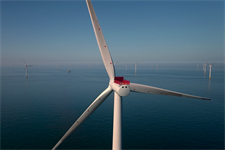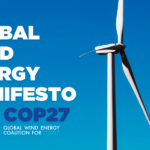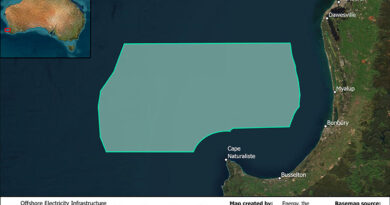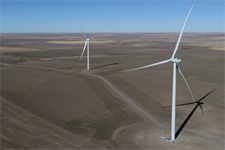UK banks on offshore wind for energy security
Energy Disrupter

With 50GW of offshore wind by 2030 planned, the wind industry has welcomed the UK government’s new energy strategy. RenewablesUK chief executive Dan McGrail said it “puts rocket boosters under the UK’s transition to renewable energy”.
Offshore wind is the backbone of the UK’s plan to see 95% of electricity being low carbon by 2030 by increasing the pace of deployment by 25%. The British energy security strategy says the 50GW will be enough to power every household in the nation. Floating wind is expected to account for 5GW of that.
Offshore wind is also pivotal to UK plans for hydrogen production. “We will aim to double our ambition to up to 10GW of low carbon hydrogen production capacity by 2030, with at least half coming from green hydrogen and utilising excess offshore wind power to bring down costs,” the government said.
“We will be the Saudi Arabia of wind power, with the ambition that by 2030 over half our renewable generation capacity will be wind, with the added benefit of high skilled jobs abounding these shores,” the strategy document says.
The government says it will offer “clear investable signals” through annual auctions, with the next round a year earlier in March 2023, helping to keep costs down through competition. It will also consult on changes to the 2024 contracts for difference (CfD) auction, allocation round 6, that incentivise renewables to locate and operate in a way that minimises overall system costs.
Keeping to the pledge to accelerate European offshore wind signed by the UK government and announced at the WindEurope event in Bilbao this week, it said the UK’s offshore wind goals will be underpinned by new planning reforms to cut approval times for new projects from four years to one year. There will also be an “overall streamlining which will radically reduce the time it takes for new projects to reach construction stages while improving the environment”, it added.
This includes strengthening renewable national policy statements to reflect the importance of energy security and net zero and making environmental considerations” at a more strategic level allowing us to speed up the process while improving the marine environment”. Strategic compensation environmental measures will also be introduced, including for projects already in the system to offset environmental effects and reduce delays to projects.
Other measures included are a new offshore wind environmental improvement package, including an industry-funded marine recovery fund and nature-based design standards to accelerate deployment while enhancing the marine environment. A fast-track consenting route for priority cases where quality standards are met will also be established, by amending the Planning Act 2008 (regulating permitting procedures) so that the relevant secretary of state can set shorter examination timescales.
UK business and energy secretary Kwasi Kwarteng said: “The simple truth is that the more cheap, clean power we generate within our borders, the less exposed we will be to eye watering fossil fuel prices set by global markets we can’t control.”
The government acknowledged that “onshore wind is one of the cheapest forms of renewable power” but resistance to it remains. “The government is serious about delivering cheaper, cleaner, more secure power, so we need to consider all options. That is why we included onshore wind in the latest contracts for difference auction round and will include it in future rounds.”
The strategy document says: “The UK already has over 14GW of onshore wind, with a strong pipeline of future projects in Scotland. We will improve national network infrastructure and, in England, support a number of new projects with strong local backing.”
The government says it will look at repowering some existing projects when they need updating or replacement, but it is also banking on local communities being charmed by the offer of cheaper energy if they allow new wind farms to be built. “In the more densely populated England, the government recognises the range of views on onshore wind. Our plans will prioritise putting local communities in control. We will not introduce wholesale changes to current planning regulations for onshore wind,” it says. “We will be consulting on developing partnerships with a limited number of supportive communities who wish to host new onshore wind infrastructure in return for guaranteed lower energy bills.”
Government said it will also consult on the rules for solar projects, hoping to increase the UK’s current 14GW of solar capacity by up to five times as much by 2035.
While onshore wind is effectively sidelined to a “limited number of supportive communities” and solar is left to wait, nuclear is set for a comeback. A significant acceleration of nuclear is planned, with up to eight new reactors delivered to take UK capacity to 24GW by 2050. This would be enough to supply 25% of the country’s electricity, the government said.
Reactions
Ed Miliband, Labour’s shadow climate secretary, said without onshore wind and more solar, the government’s energy policy will not deliver energy independence
“No reversal of the ban on onshore wind and not a penny more on energy efficiency,” he said, noting the plan “has failed on the sprint we needed on onshore wind and solar – the cheapest, cleanest forms of home-grown power”.
He said: “This relaunch will do nothing for the millions of families now facing an energy bills crisis.”
The wind industry itself is more positive. RenewablesUK’s McGrail said the strategy is “ambitious”. He said: “Reforms to speed up the planning system and how quickly we connect new offshore wind are essential to meet these new ambitions.”
He added: “Ramping up the roll-out of innovative technologies is vital too, and the increased targets for green hydrogen and floating wind will help us to build up new industries. Producing renewable hydrogen using electricity from wind will provide valuable flexibility to our future clean energy system, replacing gas in a wide variety of sectors like industry, transport and heating.”
The regulator Ofgem now needs “a clear mandate to enable investment in vital new grid infrastructure that we need to deliver projects on time and at lowest cost”, he said.
The government is right to look again at planning rules “so that onshore wind can proceed in parts of England where there is support, as it’s the cheapest source of new power and the quickest to build”, he added.
East of England
Simon Gray, executive director of policy & external affairs, at the East of England Energy Group (EEEGR) also welcomed the strategy, agreeing it will have a positive impact on the supply chain and jobs for the east of England, but said he was disappointed about the lack of progress on onshore wind. It’s “a missed opportunity for the lowest cost renewable energy,” he said.
Gray added: “We are broadly supportive of the strategy however we question how some of these targets have been arrived at when viewed against our existing planning regulations which have thwarted or delayed so many projects in the East of England. We also question whether enough stimulus is being given to support for skills and development and supply chain support to ensure we have the suppliers and the skilled workforce we will need to achieve these ambitious targets.”
Under the plans, the east of England will grow from generating around a third of the clean energy required by the nations homes to around 69% by 2030, he said. “More needs to be done to improve our infrastructure in the east of England to facilitate such growth. We also need to be aware of the impact that some of these projects and targets bring with them in terms of working with the local population and the environment.”
Ian Pease, energy development manager for the East of England’s Generate Energy told Windpower Monthly that “it’s incredible news” and a real boost for East Anglia, which “has versatile offshore energy ports, a highly-skilled energy supply chain and unrivalled centres of energy innovation”.
The region’s role in hydrogen, including wind-powered produced, will also grow, he said. “We’ve got a lot of skill sets and capabilities, businesses in the region that can pivot quite comfortably to processing hydrogen rather than processing hydrocarbons.”
The East of England currently has 4.6GW of operating offshore wind, with another 8.3GW in the pipeline by 2030, but there is space for the wind sector to grow and thrive in the region, Pease said. “We need to make sure that every inch of our ports in England can be used for assembly and construction and load up,” he said.
But he warned: “There’s no doubt that planning is a real serious concern.”
Pease said a big “social mission” for offshore wind, and as well as onshore wind, is needed. You have to think about the onshore infrastructure such as substations required to meet the new offshore wind goals. “We need to be better at how we build social permission so communities see the real benefits of new energy coming into their homes or their communities.”
That was highlighted recently when Suffolk Coastal MP Therese Coffey – also a member of the UK cabinet as secretary of state for work and pensions – expressed her disappointment when the government gave the green light to ScottishPower Renewables’ 800MW East Anglia One North Offshore Wind Farm and 900MW East Anglia Two Offshore Wind Farm (part of the new East Anglia Hub) on 31 March 2022. Coffey has been outspoken in her opposition to the developments because of the 30-acre substation to connect the projects to the onshore grid, which is planned near the quiet Suffolk village of Friston, in the East of England.
Coffey, who is a firm supporter of plans for a new nuclear plant, Sizewell C, planned nearby on the Suffolk coast, opposes the wind farms because she thinks the onshore infrastructure will have a “devastating impact” on the area. She said: “Whilst I have always supported the offshore elements of the application, I have consistently spoken against the associated onshore infrastructure and the impact on Suffolk coastal, particularly in relation to the proposed substation at Friston, engaging extensively in the planning process and suggesting alternatives.”
Generate says the wind farms planned by ScottishPower Renewables, which is owned by Iberdrola, and the UK’s new energy strategy will realise significant investment and job opportunities in the region. Pease is hopeful: “I think the industry and stakeholders have a more coherent dialogue with people concerned about the connection of offshore wind to the region. That dialogue is more genuine and honest and sensitive now and we help to allay their concerns.”
















